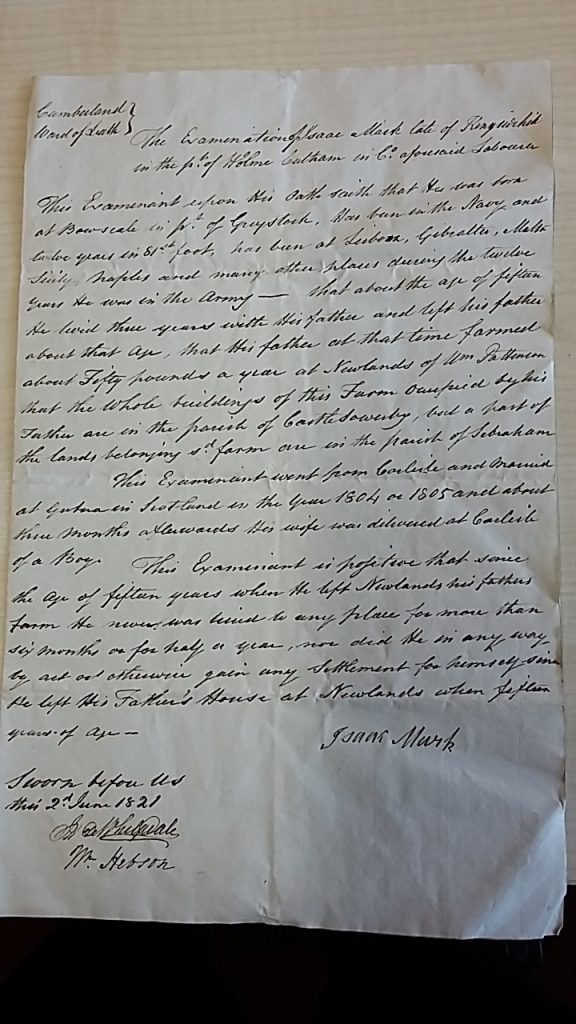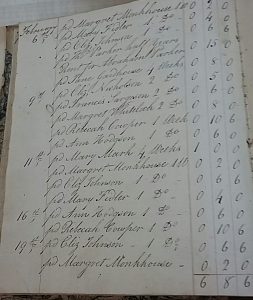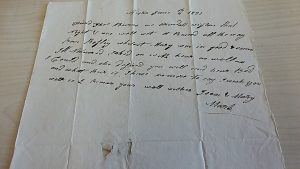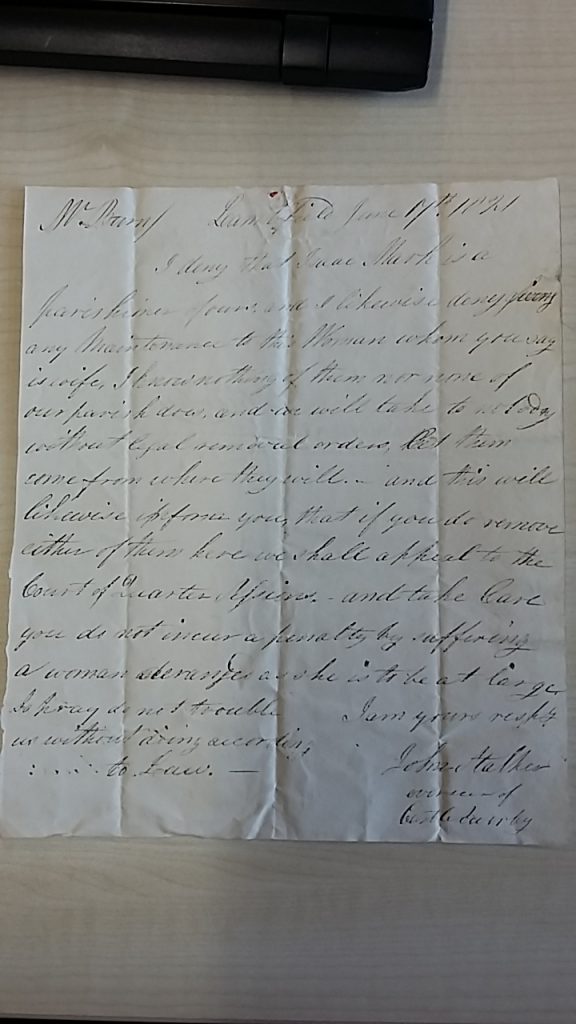Three letters which relate to Isaac Mark and his wife Mary can be found with other Greystoke overseers’ vouchers. The first dated 2 June 1821 is an examination of Isaac Mark’s antecedents by the magistrates of Leath Ward to determine his place of settlement . Isaac is described as a labourer late of Kingside Hill, Holm Cultram. Born at Bowscale in Greystoke Parish he had, until about the age of 15, worked on a farm at Newlands. His father rented it from William Pattinson for £50 a year. In 1788 Newlands was described as being in both Castle Sowerby and Sebergham Parish [1]. After that, Isaac served in first the navy for twelve years then in the 81st Foot Army Regiment for twelve years. Not being in any one place more than six months, he had been to Malta, Gibraltar, Sicily, Naples, and Lisbon amongst many other places. He was married in Gretna around 1804-5. His son was born about 3 months later. He said he had not tried to gain a settlement elsewhere.[2]

Isaac Mark was baptised on 30 October 1771, at Bowscale, Cumberland, the third son of Thomas (1736-1812) and Sarah Pattinson(1738-1805). He was the brother of George (b.1762), Mary (b.1762), Elizabeth (b.1765), Ruth (b.1767) John (b.1769), Thomas (b.1774), Sarah (b.1779) and Benjamin (b.1785). All were baptised as Quakers.[3] Isaac’s family were descendants of the Bewley and Mark families whose names dominated the Quakers of Mosedale, Cumberland. Some were persecuted for their faith. [4]
Perhaps struggling to make a living, Isaac left the farm. Military conflict may not have sat well with any Quaker principles he had.
It is not known where his wife Mary was born. The marriage document gives her surname as Marey Gels of Higton Lancshire[sic]. Their son, Thomas, appears to have been baptised in Bolton le Moors Lancashire on 17 June 1804.[5] Shortly afterwards, on 17 October 1804 Isaac enlisted in the 81st Foot Regiment at Londonderry, Ireland. He appears on a list of others in the Regiment serving in Canada [6].
While Isaac was absent Mary and Thomas were removed from Bolton le Moors to Greystoke on 3 October 1808, only to be sent back.[8 ] At a future appeal at the Quarter Sessions, they were returned to Greystoke where they were accepted by the overseers and given relief. The overseers account book shows that Mary was given £1 every 4 weeks but towards the end of 1813 payments were sometimes £2 every 8 weeks.[9]

On 14 November 1808 an order was given to remove Mary described as a widow and her son named Benjamin aged about 1 year from the Caldewgate Parish of St Mary’s in Carlisle to Castle Sowerby. The record refers to her son as Benjamin, no reference is made to her son Thomas although a subsequent document refers to a son called Thomas suggesting he was still alive. Further research has revealed that as a twelve year old the overseers of Greystoke arranged for him to be apprenticed to George Harrison a husbandman at Skelton Parish . Mary either thought she was now widowed or claimed she was. It is possible that there were two sons, Thomas and Benjamin. The 1851 census records Benjamin Mark aged 43 a Bricklayer of English Damside, Carlisle living with William Gilmore and his wife Mary Gilmore. Although referred to as Son-in-Law it may be that Benjamin Mark was his stepson and Mary Mark his wife. Isaac having died [10]
Caldewgate was mainly and area of innkeepers, tradesman and manufacturers attracting people from other areas looking for employment. The poor could be looked upon badly, more being spent on removing a pauper than relieving them.[11] Whether Mary was removed is not known.
By 7 December 1816 Mary’s status was no longer described as that of a widow. Once again the Justices ordered that Mary and her son Thomas be removed from Caldewgate Quarter to Greystoke Parish. Mary and Thomas, aged about 11 years, were described as having previously been removed from Bolton le Moors and accepted by one of the Overseers of Greystoke, Johnby, Blencow, Motherby and Gill, about seven years previously. Isaac her husband a soldier could not be found at the time, his whereabouts until lately being unknown. The Magistrates believed that he had returned to the Greystoke area and his place of settlement. They rejected Greystoke’s appeal against her removal as they had been paying her relief and should have been less submissive in accepting her from Bolton le Moors. The onus being on them to prove a settlement in another neighbouring parish.[12] Isaac may have left the army after the Napoleonic Wars about this time and have returned to what he considered home looking for work.
On 9 June 1821 a short letter to Thomas Burn the Overseer for Greystoke from Isaac and Mary stated they had arrived in Wigton. It briefly describes Isaac and Mary’s journey. He writes ‘she desires you send her bed and what there is‘. [13 ]

The last letter, dated 17 June 1821, is from John Stalker, the Overseer of Castle Sowerby to Thomas Burn warning him that if they try to send Isaac and Mary to them they will lodge an appeal at the Quarter Assizes. Stalker wrote: ‘take care you do not incur a penalty by suffering a woman deranged as she is to be at large’. Greystoke to be trying to remove both of them [14].
Together by choice or necessity it is not known if they every gained a settlement anywhere.

Sources
[1] Cumberland Pacquet and Ware’s Whitehaven Advertiser,6 August 1788, p.1
[2] Cumbria Archives. PR5/67-C item 3, Greystoke Overseers’ Voucher, 2 June 1821
[3] Quaker Birth Marriage and Death Registers, 1578-1831 [accessed at ancestry.co.uk 21 February 1821]
[4] Rev. Edward Thomas Bewley. The Bewleys of Cumberland and their Irish and other descendants (1904).
[5] Gretna Green Marriage Registers [accessed at ancestry.co.uk]; Liverpool Parish Clerk Project Online. www.lan.upc.org.uk
[6] The National Archives, Kew, WO 25/481, 81 Foot British Regimental Registers of Service 1801-1816pp. 89-90 (https://discovery.nationalarchives.gov.uk/)
[7] Lancashire Archives, Salford Quarter Sessions, QSP/2575/31, Salford Epiphany 1809 or event date 3 October 1808
[8 ] Lancashire Archives Salford Quarter Sessions QSP/2575/31, Salford Epiphany, 1809 or event date 3 October 1808; Cumbria Archives, PR 5/57, Removal orders, 1737-1833
[9] Cumbria Archives, PR 5/45, Overseers’ Account Book, 1810-14
[10] Cumbria Archives, SPC 67/38, Castle Sowerby Removals, 1778 -1835; Cumberland Quarter Sessions, Q4/2, Christmas Sessions, 1809, p. 105. Cumbria Archives PR 5/59 Bundle of Apprenticeship Indentures 1763-1837
[11] Frederick Morton Eden, The State of the Poor (1797) Volume II page 60
[12]Cumbria Archives, PR 5/57, Removal Orders, 1737-1833
[13]Cumbria Archives, PR5/67-C, item 17, 9 June 1821
[14]Cumbria Archives, PR5/67-C, item 2, 17 June 1821
This is a work in progress subject to change with further research